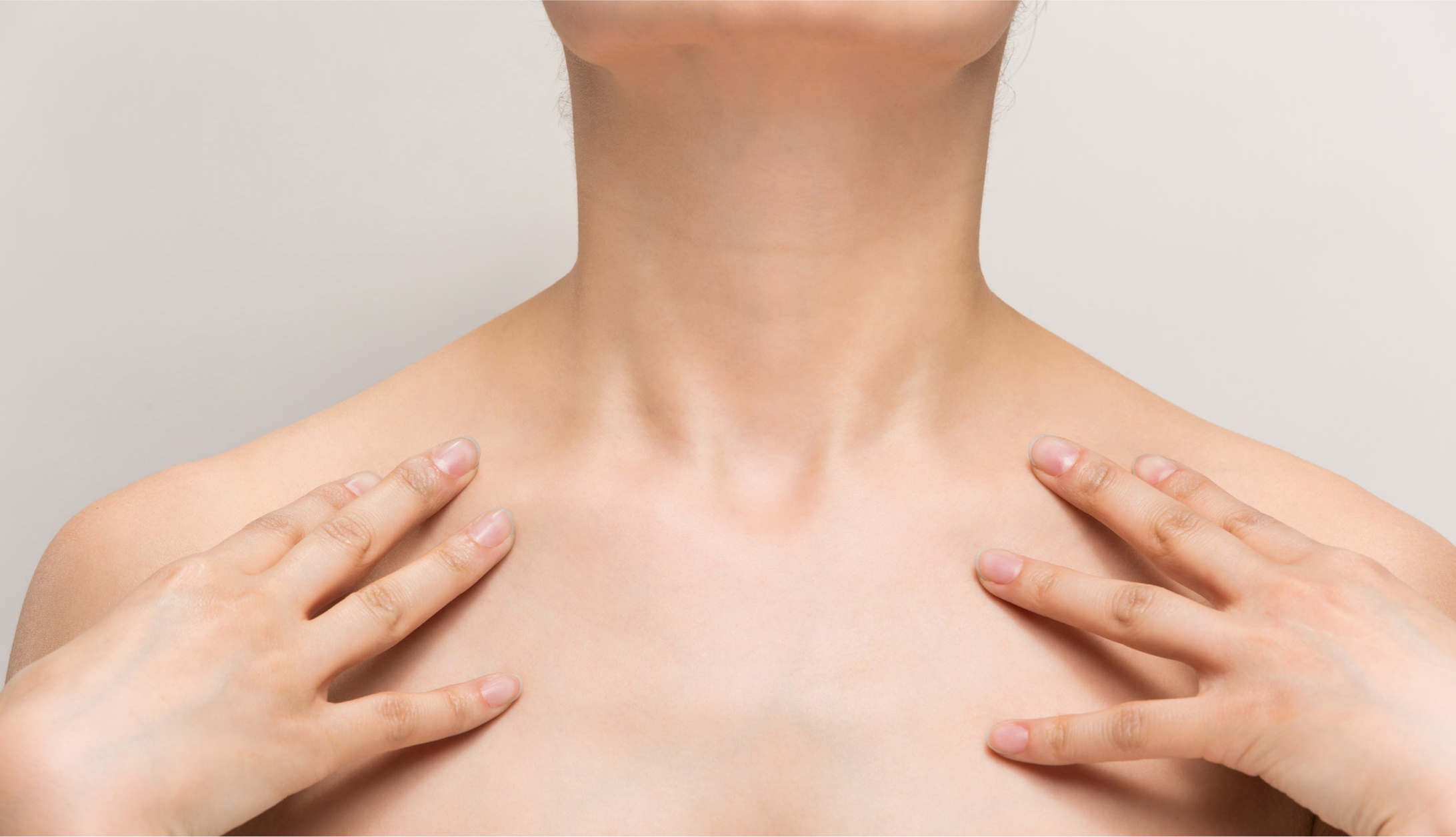
Skin ageing occurs through a combination of genetics, environmental factors, hormones and metabolic processes. Ultraviolet (UV) exposure is the main factor (Rittié and Fisher, 2002). Ageing affects the neck and décolletage in similar ways to the face; however, it is an area frequently ignored when treating the face, which leads to a mismatch between the appearance of the face and neck/décolletage. Treatment options for this area are wide-ranging.
The main ageing issues experienced by patients are loss of skin elasticity and volume, leading to wrinkles and loose skin, and dyschromia. There is also fat loss in the neck and fat descent over the jawline from the face. Furthermore, platysmal bands can develop in the thinner neck, which may be considered cosmetically unsightly.
Generally, patients with thicker skin, less dyschromia and some retained skin elasticity are likely to respond better to treatment (Shadfar and Perkins, 2014). The décolletage area has thinner skin with less adipose tissue and sebaceous glands, so it is sensitive and requires more careful treatment than the neck or face.
This article discusses non-surgical solutions for the neck and décolletage. These can be divided into:
- Topical agents
- Microneedling
- Dermal fillers and biostimulators
- Skin peels
- Muscle relaxants
- Thread lift techniques
- Light-and heat-based techniques.
Topical treatments
There are numerous topical agents that improve skin quality and appearance. The problem for both the clinician and patient is that the choice is extensive. The most important, and often overlooked, topical treatment for ageing is sun protection factor (SPF), and this must be applied effectively. This prevents photoageing from occurring or worsening.
Commonly used topical agents that improve the quality of the skin include:
- Retinoids, which have been demonstrated to significantly reverse the effects of photoageing over several months of use (Mukherjee et al, 2006)
- Vitamin C, which is a powerful antioxidant that prevents further damage to the skin due to sun exposure (Pullar et al, 2017)
- Copper polypeptides, such as Matrixyl 3000, have been shown to reduce fine wrinkles in small studies (Badenhorst et al, 2016)
- Topical hyaluronic acids increase hydration and improve skin tightness and fine wrinkling (Juncan et al, 2021).
There are a variety of other topical therapies that can be employed, and each clinic will have its own favourites.
Microneedling
Pająk et al (2022) found 52 studies on microneedling and concluded that it is a safe, low-cost treatment that can increase collagen by up to 400% after 6 months and stratum granulosum thickness for a year after treatment. It requires 2–4-week intervals between treatments, and the number of treatments recommended varies, but between four and six is the consensus.

Radiofrequency microneedling is a more sophisticated form of the treatment and likely requires a smaller number of treatments than conventional microneedling but at a higher cost. It is safe and effective in tightening the skin and treating photoageing (Austin et al, 2022).
Dermal fillers and biostimulators
A variety of methods can be used to improve the appearance of the neck and décolletage area.
Skin boosters containing free hyaluronic acid can be injected in a number of methods to improve skin elasticity and hydration and are safe with minimal side effects (Ayatollahi et al, 2020a).
Fine lines, such as necklace lines, can be treated with direct injection in the superficial to mid dermis using a cohesive low G prime dermal filler. Blanching is commonly seen using more superficial techniques and provides a satisfying result in many cases.
A more global technique is suited mainly to the neck and involves using products such as calcium hydroxyapatite, which stimulates both collagen and elastin (de Almeida et al, 2019). The product is often hyperdiluted to 50:50 to reduce any initial volumising effect. Another technique is injecting polylactic acid with a cannula, which produces effective, long-term results (Christen, 2022). Nodule formation is a concern, but it can be minimised by the correct technique and higher dilutions.
Platelet-rich plasma (PRP) is a safe and underused treatment for the neck and décolletage, and it has shown promising results in a few small studies (Redaelli et al, 2010).
Many of these techniques are off-label, and the results are long term over months and can require several treatments.
Skin peels
Chemical peels have been shown to provide excellent results in the treatment of neck and décolletage to reduce fine wrinkles and improve dyschromia. A large study using 70% glycolic acid and 40% TCA had excellent results (Cook and Cook, 2000). A review of techniques concluded that chemical peel use is increasing and is predictable and has a favourable risk profile (Pathak et al, 2020). Superficial to medium depth peels tend to be favoured due to their effectiveness, safety and low cost (Soleymani et al, 2018).
Muscle relaxants
Botulinum toxin is helpful in the neck to treat platysmal bands and the inferior platysma (décolletage) with minimal side effects (Ascher et al, 2010). Treatment is into the bands and lower jaw line and a V-shaped pattern in the neck.

Thread lifting
There are a variety of thread types and techniques. Commonly used threads are polydioxanone (PDO) and poly-lactic acid (PLLA). This treatment tends to use horizontally placed threads. A systematic review found thread lifting to be safe, with most side effects resolving without intervention (Pham et al, 2021).
However, Gülbitti et al (2018) expressed concern about the general longevity of thread lifting techniques. Additionally, Diaspro and Rossini (2021) concluded that the effects of threads, in terms of lifting, last up to 12 months. One paper concluded that the age, type of thread, site and technique had no effect on patient satisfaction (Hügül et al, 2022). Therefore, thread lifting is an option when surgical procedures may not be sought.
Laser and heat-based devices
There are multiple devices for skin rejuvenation. Skin tightening can be achieved with many of these devices. High-intensity focused ultrasound (HIFU) is a safe and effective method of tightening the neck skin (Azuelos et al, 2019) with ‘moderate efficacy’ (Ayatollahi et al, 2020b).
Tixel is a thermomechanical device that is suitable for treating most ageing issues, and it is appropriate for a broader range of skin types and may have some advantages over lasers in some cases (Arias, 2022).
Light treatments of the neck and décolletage are myriad.
Mokhallalati et al (2018) concluded that CO2 and Erbium laser resurfaced the skin, providing tighter and newer skin, but with significant downtime. Sturm et al (2022) favoured Er:YAG over CO2 laser because of less thermal spread. Oram and Akkaya (2014) considered fractional CO2 to be a safe and effective skin tightening and textural improvement treatment.
Intense pulse light treatments are helpful for treating dyschromia, with up to 75% improvement in hyperpigmentation and telangiectasia (Yaar, 2006).
Light-emitting diodes may have minimal effects on skin ageing, but it is a safe and low-cost treatment.
Conclusion
There are many treatment options for the neck and, to a lesser extent, the décolletage area. Often, these areas are ignored by patients and practitioners, but the neck does not lie when it comes to ageing and, therefore, justifies some attention.
It is not possible to prescribe a treatment protocol for these areas. The reason is that there are few, if any, comparative studies on treatments, and each patient is different in terms of their needs, preferences and budget. Each clinic will have its favoured treatments.
The neck and décolletage may require different treatment approaches. Treatment is likely to be combination therapy. It will take time requiring a sizable budget and a committed patient. Sadly, unbiased advice is often lacking in the aesthetic speciality where quick fixes abound. High-quality, unbiased advice, managed expectations and effective treatments that are delivered by knowledgeable clinicians are likely to produce satisfied patients.
CPD reflective questions
- Is genetic predisposition the primary cause of neck ageing?
- Is botulinum toxin contraindicated in the décolletage due to lack of suitable muscle?
- Is Tixel an effective treatment for the neck?
Key points
- The appearance of the neck and décolletage often reveal a patient's age
- The neck and décolletage may require different treatments
- Treatment options are extensive
- There are few, if any, comparative studies comparing treatment options
- Combination of treatments are likely to provide optimal results.



